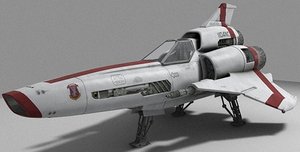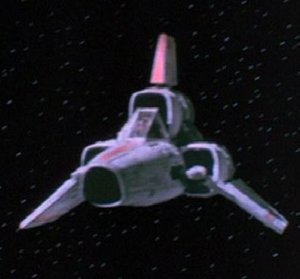mNo edit summary |
No edit summary |
||
| Line 59: | Line 59: | ||
==== Notes ==== | ==== Notes ==== | ||
Since the ''Galactica'' only had 40 Viper Mk. II's aboard, they needed as many fighters as possible, thus the remaining Mk. VII's were refitted and stripped of their advanced computer systems. However, since this is not how the Mk. VII was designed, it makes the craft increasingly difficult to handle and can only be flown by the most experienced pilots ([[Apollo]] & [[Thrace, Kara|Starbuck]]). | Since the ''Galactica'' only had 40 Viper Mk. II's aboard, they needed as many fighters as possible, thus the remaining Mk. VII's were refitted and stripped of their advanced computer systems. However, since this is not how the Mk. VII was designed, it makes the craft increasingly difficult to handle and can only be flown by the most experienced pilots ([[Apollo]] & [[Thrace, Kara|Starbuck]]). Galactica has roughly 6-8 Mk. VII's ("[[Scattered]]", "Flight of the Phoenix"). | ||
=== Layout === | === Layout === | ||
Revision as of 16:40, 17 September 2005
Re-imagined Viper[edit]
Overview[edit]

The Viper is the Colonial Defence Force's primary space superiority fighter / attack craft. Capable of atmospheric flight, the Viper is a single-seat craft mounting two kinetic energy weapons (KEWs), as well as having hardpoints beneath the wings for mounting missiles, munitions pods and other ordnance (The Hand of God).
The Viper was originally introduced into Colonial service shortly before the outbreak of the Cylon War. However, it was the Mk. II variant, designed specifically for use with the new Colonial Battlestars that is best remembered.
The Mk. II served with distinction throughout the Cylon War, proving a capable fighting vehicle that won renown across the Twelve Colonies and is regarded as one of the reasons the Colonials did not suffer defeat at the hands of the Cylons.
The Mk. II remained in service after the end of the war, but was subsequently superceded by newer models. At the time of the renewed Cylon attack on the Twelve Colonies, the Mk. VII was the front-line variant of the Viper design, retaining the Mk. II general layout but using fully networked systems providing superior battle management and fight information for the pilot.
Ironically, it was the incorporation of the new integrated systems that prevented the majority of Mk. VIIs from being effective during the Cylon attack: as with the majority of Colonial Fleet, the Mk. VII suffered fatal computer glitches on contact with Cylon forces. Thanks to Six's relationship with Baltar, the navigational software in standard use onboard the majority of Colonial Fleet vessels had backdoors that allowed the Cylons to infiltrate a vessel's network by wireless signals and disable its power systems. While the problem could be overcome by removing the navigational upgrade compromised by the Cylons, this information was not discovered in time to be of major benefit to the surprised and hard-pressed Colonial forces.
Atmospheric Operations[edit]
The Viper is designed for atmospheric as well as space-based operations. However, Vipers consume more fuel during atmospheric operations than in the vacuum of space: once in an atmosphere, the engines must run continuously to retain airflow over the wing lifting surfaces. Depending on the composition of the atmosphere itself, this can place severe strain on the Viper's engines (You Can't Go Home Again).
Due to their wing configuration, Vipers may also suffer from poor handling at low speeds within an atmosphere.
Life Support[edit]
Viper cockpits are pressurised and heated, but they are flown with the pilot wearing a flight suit that is capable of providing full life support should ejection be required (You Can't Go Home Again). The life support systems are built-in to the back of the pilot's seat itself, together with the flight harness. Following an ejection, the back of the seat separates automatically, effectively becoming a backpack for the pilot (Act of Contrition).
Should ejection take place within an atmosphere, the life support backpack / seat back also incorporates a parachute.
Technical Specifications[edit]
Dimensions[edit]
Mk. II
- Length: (approx) 7.6m
- Wingspan: (approx) 3.7m
Mk. VII
- Length: (approx) 8.5m
- Wingspan: (approx) 4.3m
Propulsion[edit]
- Both: 3x sublight engines mounted aft; 2x reverse thrust motors; RCS points
- Mk. VII: Angular exhaust nozzle design suggest possible thrust-vectoring.
Armaments[edit]
- Mk. II: 2x forward-firing kinetic energy weapons (KEW) mounted in the wing roots
- Mk. VII: 3x forward-firing kinetic energy weapons (KEW); 2 mounted towards the outboard sections of the wings; 1 mounted in the vertical stabiliser
- Both: Weapon hardpoints for mounting missiles / munitions pods, etc. under the wings
Instruments[edit]
- Mk. II: Radio Magnetic Indicator
- Mk. II: Torque Percent Gauge
- Mk. II: Attitude Indicator
- Mk. II: Altimeter
Crew[edit]
- Pilot
Notes[edit]
Since the Galactica only had 40 Viper Mk. II's aboard, they needed as many fighters as possible, thus the remaining Mk. VII's were refitted and stripped of their advanced computer systems. However, since this is not how the Mk. VII was designed, it makes the craft increasingly difficult to handle and can only be flown by the most experienced pilots (Apollo & Starbuck). Galactica has roughly 6-8 Mk. VII's ("Scattered", "Flight of the Phoenix").
Layout[edit]
The Viper is a long, sleek vehicle that can be spilt into two parts, fore and aft.
- Fore section: comprises the nose back to the cockpit. This contains the forward RCS systems for manoeuvring the craft; the forward landing gear; the main avionics and sensor packages, plus the single-seat cockpit itself
- Stern section: comprises the main engines, fuel tanks, wings and vertial stabiliser. The wings themselves contain the kinetic energy weapons ("guns") and their munitions storage and feeds. Hardpoints beneath the wings allow missiles, munitions pods and other items to be rack-mounted (The Hand of God). The wings roots contain the main landing gear. This section of a Viper also contains a number of RCS manoeuvring packs.
The stern section of a Viper is distinctive because of the offset "intakes" mounted just behind the cockpit. The port / starboard "intake" nacelles incorporate small but powerful reverse thrust engines that can quickly counter a Viper's forward momentum in an emergency (The Hand of God).
Original Series Viper[edit]

The Colonial Starhound Viper was the primary space superiority fighter / attack craft deployed by the Colonials. Capable of atmospheric flight, it was a single-seat craft mounting two laser-torpedo guns as standard, as well as having hardpoints for mounting missiles.
The Viper was originally introduced into Colonial service during the 1,000 yahren war with the Cylons, and was a far superior craft to the Cylon Raider.
Propulsion was said to be provided by a hybrid tylium / fusion reactor powering three ion engines with a "turbo-boost" facility for very rapid acceleration. For atmospheric flight, the engines are additionally supplied with atmospheric gases as combustibles to conserve on-board fuel supplies. The viper cockpit is fully pressurised, and in the event of catastrophic system damage, the entire module can detach and eject away from the damaged Viper.
Dimensions[edit]
- Length: (approx) 8.7m
- Wingspan: (approx) 3.8m
Propulsion[edit]
- 3x ion engines mounted aft
Aramaments[edit]
- 2 x forward-firing laser-torpedo guns
- 4 x two-hundred kiloton Solonite missiles
- 2 x thirty megaton Solonite bombs
Crew[edit]
- Pilot
Layout[edit]
The Viper is a long, sleek vehicle that can be spilt into two parts, fore and aft.
- Fore section: comprises the nose back to the cockpit. This contains the targeting dish and sensor array, the forward landing gear; the main avionics and sensor packages, plus the cockpit module
- Stern section: comprises the main engines, reactor systems, turbo-boost injection systems, fuel tanks, wings and vertial stabiliser. The wings themselves contain the laser-torpedo guns and their power packs. Harpoints beneath the wings allow missiles, munitions pods and other items to be rack-mounted.
Video Game Variants[edit]
Within the Video Game, three variants of Viper are available: the Mk. I, which is designed to be an earlier version of the original series Viper; the Mk. II, which is largely based on the original series Viper, and the Mk. III, which is described as "superior to the Mk. II in every respect".
